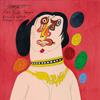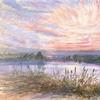
Ann Purcell: Kali Poem Series
https://www.berrycampbell.com/exhibition/123/
Berry Campbell Gallery is pleased to announce an important exhibition curated from Ann Purcell’s “Kali Poem” series. For Purcell, the desire to achieve more spontaneity led to this series, created from the mid-1980s into the early 2000s. However, such inevitability was not intentional. Instead, it was the result of a compulsion she felt. She notes: “For the first time in my work, it was not out of joy, but from some other place, some other sphere. They just seemed to appear.”
However, she knew they had a meaning, and the answer came to her from a favorite poem: May Sarton’s “The Invocation to Kali,” published in Poetry (1971). In fact, such a hindsight recognition is perfectly in keeping with Sarton’s poem, as the poem is one of process and reckoning. In four sections, the poet and reader examine the human need to destroy. The poem’s fifth section, the “Invocation,” is an entreaty to the Hindu goddess Kali to “be with us,” in order to “bring darkness into light.” For Sarton, it is the power represented by Kali—a goddess with a seemingly terrible form who is a destroyer of evil forces and also a kind protector of the universe—that gives recognition to how we must strive to bring creation out of destruction.[i] One section of the “Invocation” had long lodged in Purcell’s mind. It consists of the lines: “Help us to be the always hopeful / Gardeners of the spirit / Who knows that without darkness / Nothing comes to birth / As without light / Nothing flowers.”
Since 2013, Berry Campbell Gallery has represented Ann Purcell exclusively. Purcell is preparing for an upcoming solo exhibition at the Provincetown Art Association and Museum and will be included in a group exhibition at the American University at the Katzen Arts Center next year. “Ann Purcell: Kali Poem Series” is on view from October 15, 2020 through November 14, 2020. The gallery is open with regular fall hours, Tuesday – Saturday, 10 am – 6 pm.
[i] Kali is associated with Shiva (as his consort, wife, or associate), a god of destruction and creation. She is depicted with either four or ten arms and is usually dark-skinned (black or blue), indicating that she was created from darkness when the creation had yet to occur. Her features include eyes that are red with intoxication and rage, sharp fangs, claw-like hands with long nails, a red tongue that extends outward, and hair flying and disheveled. She is often shown on a battlefield, wearing a garland of human heads, which represent her killing rage but also her creative powers (the heads symbolize the letters of the Sanskrit alphabet and the beginning of language). Many images portray her naked (conveying her purity) and dancing, standing with her right foot on Shiva’s chest, holding a Khadga (a crescent-shaped sword) in each hand as well as a severed head and a cap to collect its blood. See David R. Kinsley, Hindu Goddesses: Visions of the Divine Feminine in the Hindu Religious Traditions (Berkeley, Calif.: University of California Press, 1988), pp. 116–31.
- Contact:
- Elisabeth McKee
- em@berrycampbell.com
- 2129242178
















